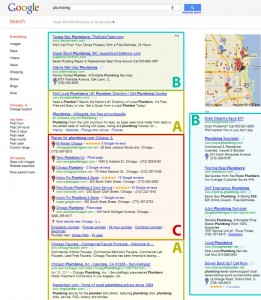C. Local SEO (Search Engine Optimization)
 When someone types a search term that shows local intent, either by including a location in the search or simply by searching using a term commonly considered to be serviced locally, Google and Bing serve up results specific to that searcher’s location. These are the local results (image C) that correspond to the Google places listing for that area (see Google maps).
When someone types a search term that shows local intent, either by including a location in the search or simply by searching using a term commonly considered to be serviced locally, Google and Bing serve up results specific to that searcher’s location. These are the local results (image C) that correspond to the Google places listing for that area (see Google maps).
Basically, a local search section is a search engine’s version of the yellow pages. Terms such as “plumber,” “doctor” or “pizza” trigger heavy local search results while terms such as “dresses,” and “TVs” do not. Unlike the phonebook, the businesses within the local results are not listed alphabetically. That is where Local Search Engine Optimization, or Local SEO comes into play. While somewhat similar to standard SEO, Local SEO has an entirely different focus. With Local SEO the goal is to rank within the local search results for commonly searched terms within your local area.
Advantages: The primary advantage of a local SEO campaign is that it can allow a smaller business to compete for popular keywords on a local level. The keyword “Pizza” for example returns over 350 million pages when searched in Google. A small pizza shop could never compete in such a broad landscape. With local SEO however, the small pizza shops to not have compete against Pizza Hut as a whole, they instead compete directly with each local branch.
Disadvantages: The main disadvantage of a Local SEO campaign is it’s limited reach. Many businesses service regions larger than thier local city or town. The local search results generally only return business listings within the city of the searcher.

